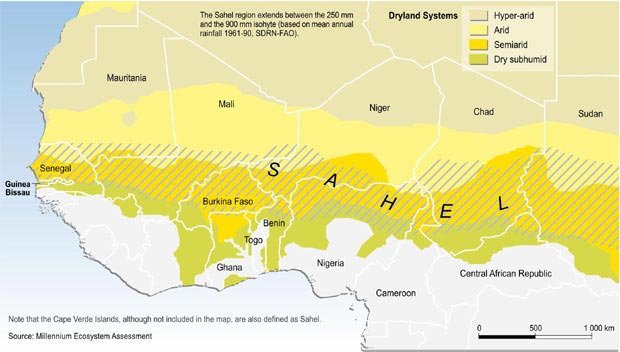


Box 7.1Droughts in the Sahel Region: Lessons Learned and Knowledge GapsThe Sahel region in Africa has been hit by a series of droughts and subsequent famines in the 1970s and 1980s (C5 Box 5.1, C22.6.4). These droughts are natural phenomena in the Sahel, and the consequent land degradation in the Sahel has further reduced regional rainfall (C13.6.1). More recently, the warming of the Indian Ocean is also thought to have contributed to these droughts. Droughts in the Sahel reduced productivity, leading to low vegetation cover that increased albedo, reduced water recycling and monsoon circulation, thus decreasing precipitation. Reduced vegetation cover also led to soil erosion and further reduction of productivity. This vicious cycle further suppressed vegetation cover (C13 Box 13.1). Reduced vegetation cover could also be attributed to human activities such as unsustainable land use practices, including overstocking, overgrazing, deep ploughing, and monocropping (C5 Box 5.1). These practices—partly in response to droughts or increasing population density in the Sahel region—contributed to soil degradation, increased wind erosion, and higher levels of dust (C13.4.3). Thus it has been suggested that the combination of human and natural factors led to the severe loss of land productivity and subsequent famines. However, long-term remote sensing studies indicate extensive recovery of vegetation productivity after the droughts, suggesting that it was almost completely controlled by rainfall (C22 Box 22.2, C13.3.2, C19.2.3). Because productivity was restored in many parts of the Sahel region, the relationship between famine, drought, and desertification is not clear. The complex interactions between regional and local biophysical conditions and human intervention make it difficult to determine cause-and-effect of desertification correctly. More reliable data in Sahel are needed to better understand the magnitude of desertification and to reduce uncertainties for policy-makers. It is clear, though, that the sustainability of livelihoods based on ecosystems experiencing serious droughts or desertification depends on appropriately tailored management approaches.  Source:
MA
Related publication:
Other Figures & Tables on this publication: Figure 1.1. Schematic Description of Development Pathways in Drylands Figure 1.2. Land Uses in Drylands Figure 4.1. Key Desertification-related Findings of the MA Scenarios Appendix A: Present-day Drylands and Their Categories Box 7.1Droughts in the Sahel Region: Lessons Learned and Knowledge Gaps Figure 7.1. Overlap of Urban Areas with the Four Dryland Categories |